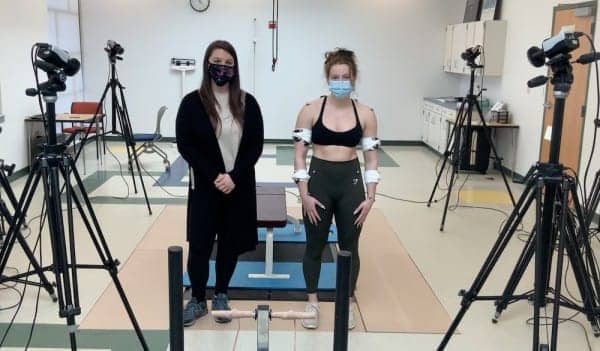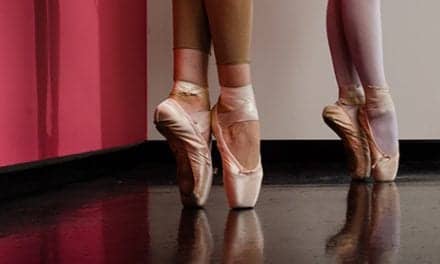CAPTION: Kinesiology graduate students Tabatha Hartshorn and Kendra Graham use motion capture technology in The University of Rhode Island College of Health Science’s new Biomechanics Lab to study ways to prevent and treat repetitive motion shoulder injuries. (URI Photo/Patrick Luce)
As part of their master’s thesis study examining the relationship between muscle activation and injury, two kinesiology graduate students at The University of Rhode Island aim to help swimmers prevent and treat the shoulder injury commonly known as swimmer’s shoulder.
In their study, Tabatha Hartshorn and Kendra Graham — themselves both former competitive swimmers and coaches — compare the muscle activation in swimmers with and without shoulder pain through the catch and pull of the freestyle stroke, during which a swimmer reaches above the head and then pulls with a bent elbow through the water until the arm is parallel with the body.
“We are looking at swimmers’ shoulders to see if there is any differences between swimmers that have reported to have pain or not have pain in their shoulders. As past swimmers, we both have not only experienced it ourselves, but have seen other athletes experience shoulder pain and not really have a reason why, or it just gets written off. We feel like there’s probably a why behind the pain, and we want to know why.”
— Tabatha Hartshorn, noting that shoulder pain is often dismissed as merely an overuse injury
In the College of Health Science’s new Biomechanics Laboratory, which is equipped with virtual reality motion capture technology, the students will apply EMG electrodes to the bodies of 20 swimmers, 10 with shoulder pain and 10 without. While the swimmers perform the “catch and pull” freestyle swimming motion on a modified weight bench in the lab, their movements are recorded with motion capture cameras. Muscle patterns are analyzed through electromyography on the upper and middle trapezius muscles, the biceps brachii, and triceps brachii while the athlete is performing resistance exercises and simulated ergometer swimming exercises.
The motion capture cameras create a skeletal image of the swimmers on a computer monitor, allowing researchers to monitor the arm movement and the level of stress placed on the muscles throughout the swimming stroke. They can see what position a swimmer is in when the muscles are activated and if that’s the motion they expect, or if the athlete’s motion is altered due to the pain he or she is feeling, allowing them to pinpoint damage and the exact motion that causes it, a media release from The University of Rhode Island explains.
View a video that explains more about the study here.
“We started the study because we were both interested in swimmers’ injuries; we noticed there were a ton of shoulder problems in ourselves and our peers, and we wanted to learn why. We hope by doing this research, we may be able to find a muscular or kinematic reason so future swimmers and coaches will have something to use in the weight room or in practice to prevent and treat their injuries.”
— Kendra Graham
[Source(s): The University of Rhode Island, Newswise]






I applaud the investigators in this study for trying to tackle a very difficult question. My concerns are in the methodology of this study because this simulation has the trunk an torso fixed which has 2 issues. First, if one is looking to analyze the arm during freestyle, the arm moves unilaterally with considerable trunk rotation so the mechanics in this study do not replicate a normal freestyle stroke and the muscle activation patterns will be very different than what actually occurs. Secondly, in the water the trunk is able to advance forward as the the arm pulls through the resistance of the water. Once again, we have very different biomechanics which would lead to different recruitment patterns of the musculature, particularly the scapular stabilizers.
Thank you for your input, Brian.